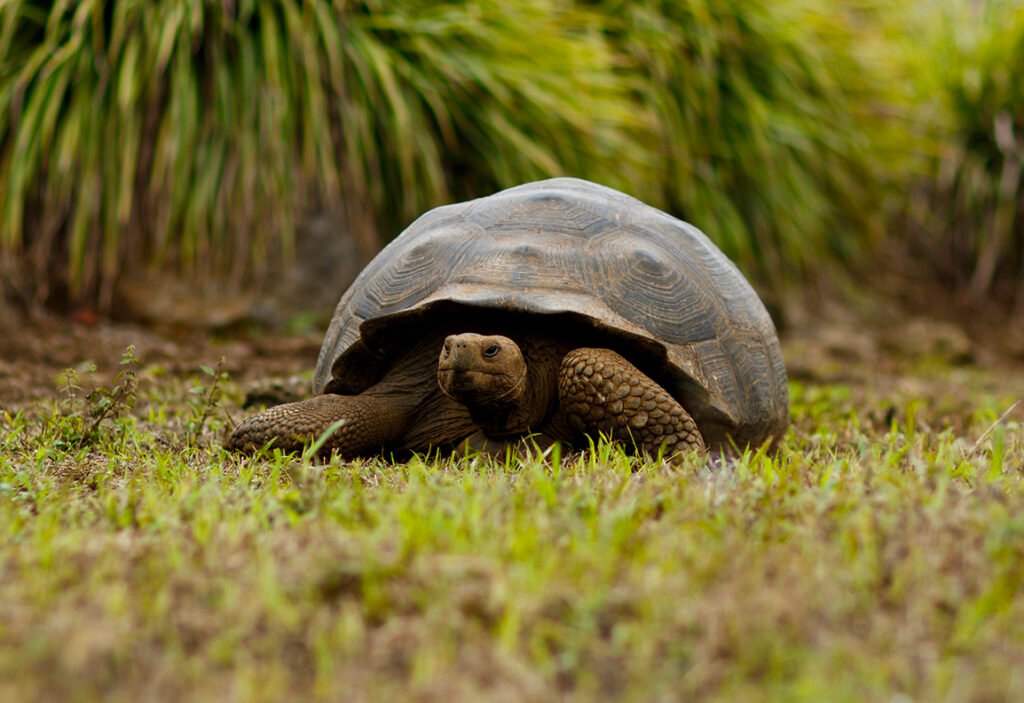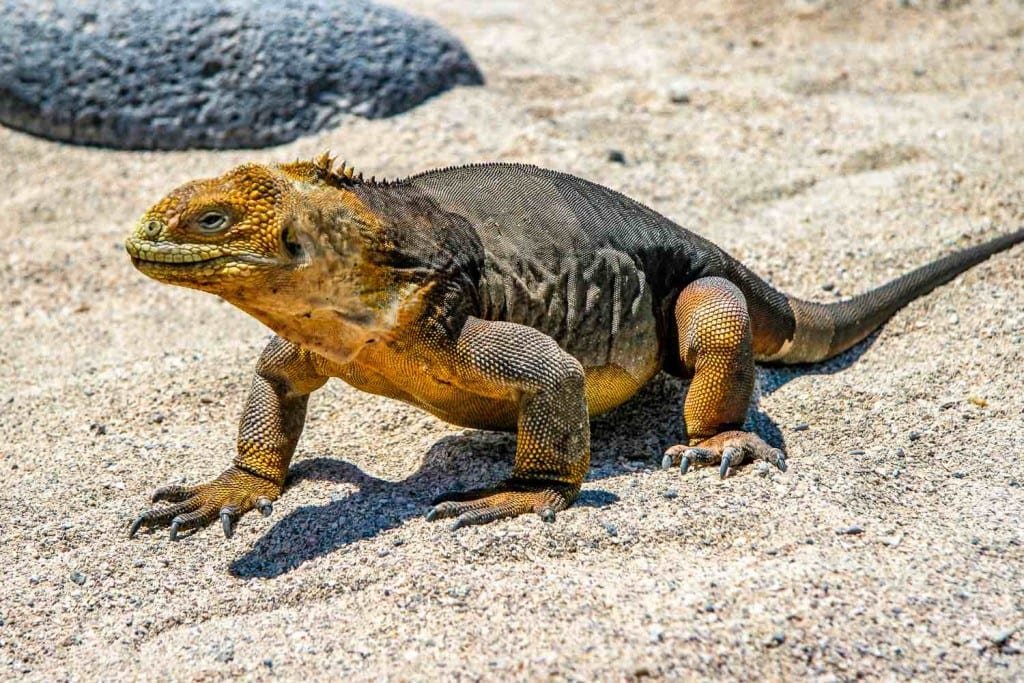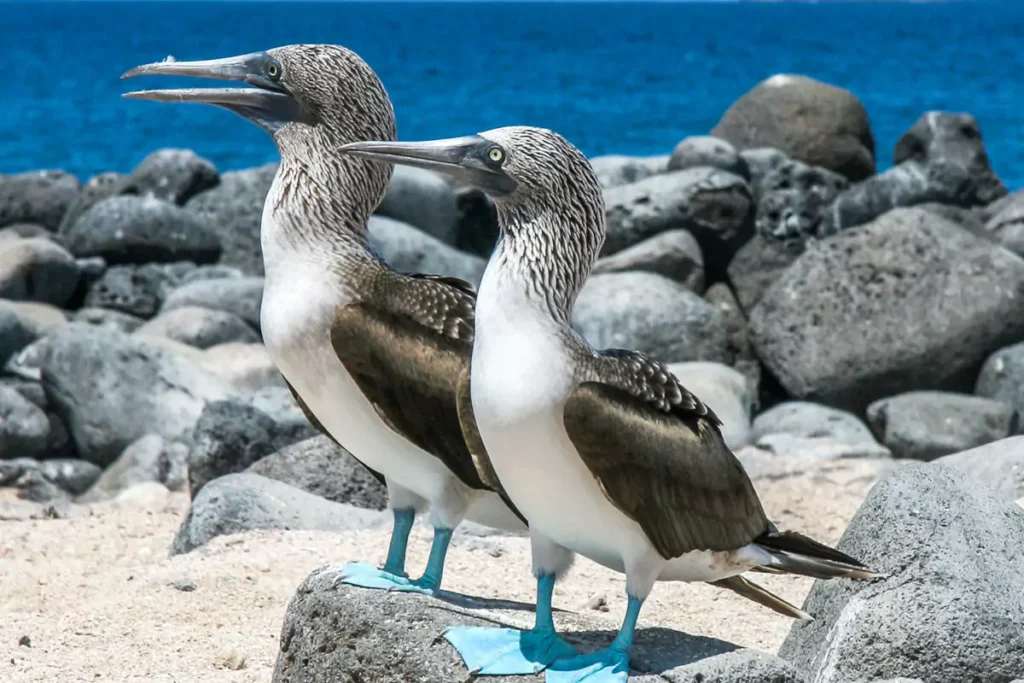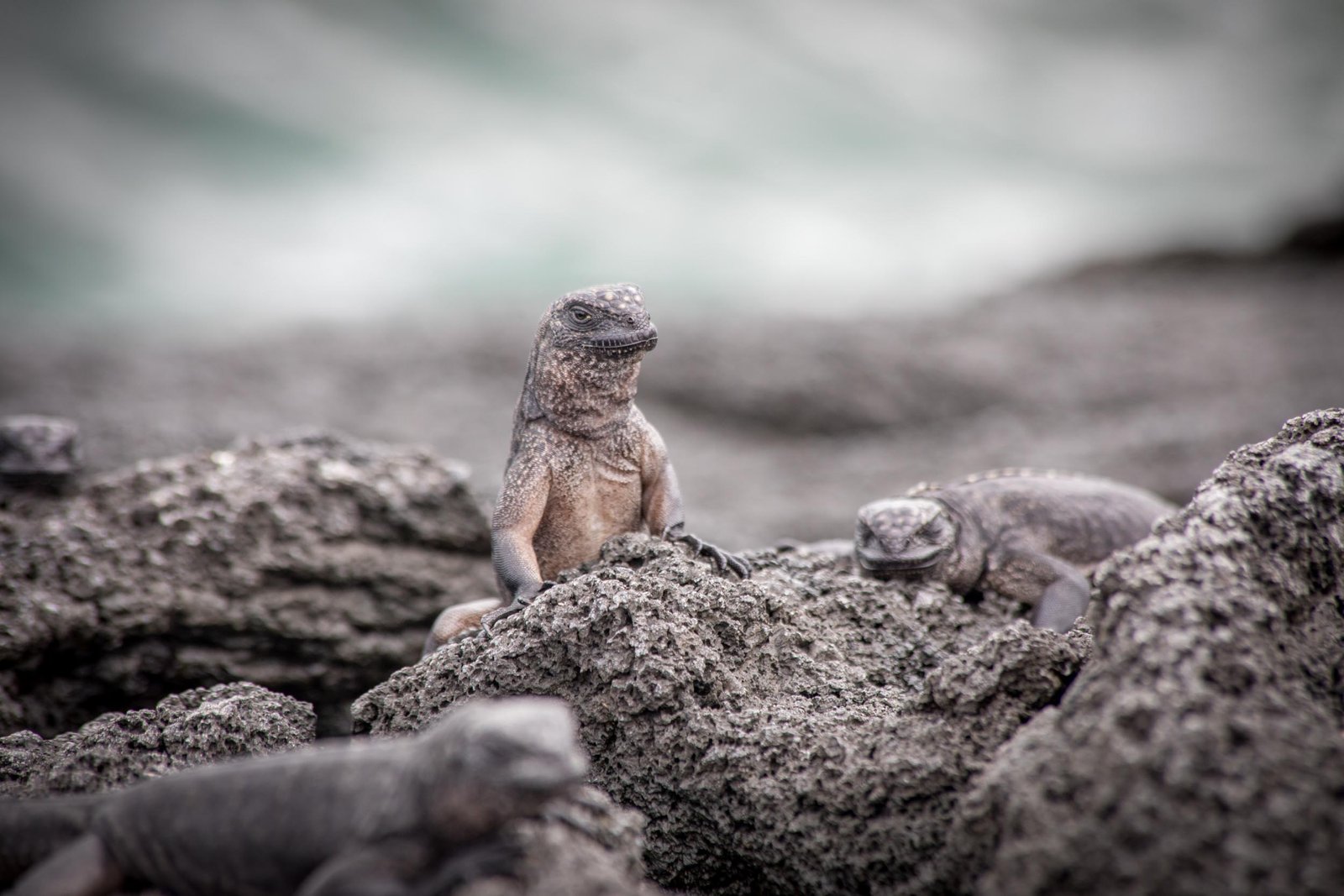Galapagos Trip: How is the Weather?
“Considering that these islands are placed directly under the equator, the climate is far from being excessively hot; this seems chiefly cause by the singularly low temperature of the surrounding water, brought here by the great southern Polar current. Except during one short season, very little rain falls, and even then it is irregular; but the clouds generally hang low.”
— Charles Darwin

Climate
The Galapagos are equatorial. You might expect a tropical climate, but most areas of the islands are arid and dry. Year round, you can expect highs from the upper 70s to upper 80s, with lows between 75F and 65F.
During the cool season (roughly June to November) you may encounter mist, but virtually no rain. The mist is welcome; these islands receive direct overhead sun, and have very little shade. Expect highs in the upper 70s, and water temperatures near 72F.
The nutrient-rich Humboldt Current prevails, and water temperatures approach 72F.

Counterintuitively, the rainiest months are also the sunniest; air temperatures are finally high enough to condense the mist to rain.
But even the rainiest month, March, has only about two inches of precipitation for the entire month. High temperatures reach the upper 80s, with lows near 72F. The Panama Current prevails, with water temperatures near 75F.

Seasons in the Galapagos
Wet, or Warm Season (December to May) temperatures hover in the mid 80’s and even the 90’s. Rainfall is uncommon but strong, and water temperatures near the surface can average 75°. The island’s lack of shade and the equatorial sun combine to take a toll on visitors. Reflective sand and lava can magnify the effect. Winds and seas are generally calmer.
Garua, Dry, or Cool Season (June to November) brings merciful fog, drizzle, and cool winds. Overnight air temperatures drop into the high 60’s, with similar water temperatures near the surface. These months are the height of the breeding season for many of the island’s avian species. Winds and seas are less calm.

Busiest Months in Galapagos
The busiest months are mid-May to August and mid-December to mid-January. June to September is a season with families from North America, South America, and Europe on school vacation. December to January is festive season—also a busy time for families*. The most sought-after festive season space often sells out 18 months in advance.
*Cruises have a minimum age of six years old, while land-based programs do not usually have a minimum age.

Galapagos Weather Summary
Bottom line, this is a year-round, equatorial destination with very little seasonal or temperature change. Species migration is rarer than elsewhere; most birds are in residence continually. Rainfall is low and welcome. Seas are generally calm. There is no “bad” or “wrong” time to visit.

January in Galapagos
Climate
- Average high: 86F
- Average water temperature: 76F
- Ocean current: Panama (warm) current
- Precipitation: light
- Sun intensity: high
Wildlife
- Nesting: Giant tortoises, green sea turtles, red-footed and masked boobies, flamingos, magnificent frigates, great frigates, Galapagos penguins, finches, flightless cormorants
- Mating: Land iguanas, marine iguanas, red-footed and masked boobies, flamingos, Galapagos penguins, finches, flightless cormorants
- Absent: Waved albatrosses
Other
- Excellent underwater visibility

February in Galapagos
Climate
- Average high: 86F
- Average water temperature: 77F (annual high)
- Ocean current: Panama (warm) current
- Precipitation: light
- Sun intensity: high
Wildlife
- Nesting: Giant tortoises, green sea turtles, red-footed and masked boobies, flamingos, magnificent frigates, great frigates, Galapagos penguins, finches, flightless cormorants, land iguanas, marine iguanas
- Mating: Red-footed and masked boobies, flamingos, Galapagos penguins, finches, flightless cormorants
- Absent: Waved albatrosses
Other
- Excellent underwater visibility

March in Galapagos
Climate
- Average high: 86F
- Average water temperature: 77F
- Ocean current: Panama (warm) current
- Precipitation: highest this month, but still only two inches on average
- Sun intensity: high
Wildlife
- Nesting: Giant tortoises, green sea turtles, red-footed and masked boobies, flamingos, magnificent frigates, great frigates, Galapagos penguins, finches, flightless cormorants, land iguanas, marine iguanas
- Mating: Red-footed and masked boobies, flamingos, Galapagos penguins, finches, flightless cormorants
Other
- Excellent underwater visibility
- Galapagos tortoise eggs are hatching
- Waved albatrosses begin to arrive on Espanola Island

April in Galapagos
Climate
- Average high: 88F
- Average water temperature: 77F
- Ocean current: Panama (warm) current
- Precipitation: second highest this month, but still under two inches on average
- Sun intensity: high
Wildlife
- Nesting: Giant tortoises, green sea turtles, red-footed and masked boobies, flamingos, magnificent frigates, great frigates, Galapagos penguins, finches, flightless cormorants, land iguanas, marine iguanas, waved albatrosses
- Mating: Red-footed and masked boobies, flamingos, Galapagos penguins, finches, flightless cormorants, waved albatrosses
Other
- Galapagos tortoise hatching season concludes
- Green sea turtle eggs begin hatching

May in Galapagos
Climate
- Average high: 82F
- Average water temperature: 76F
- Ocean current: Panama (warm) current ends
- Precipitation: under one inch; dry season begins
- Sun intensity: moderate
Wildlife
- Nesting: Giant tortoises, green sea turtles, red-footed and masked boobies, flamingos, magnificent frigates, great frigates, Galapagos penguins, finches, flightless cormorants, land iguanas, marine iguanas, waved albatrosses
- Mating: Sea lions, blue-footed boobies, red-footed boobies, masked boobies, flamingos, Galapagos penguins, finches, flightless cormorants
Other
- Along with June, May has the pleasant weather
- Land iguana eggs are hatching
- Green sea turtle eggs are hatching

June in Galapagos
Climate
- Average high: 79F
- Average water temperature: 73F
- Ocean current: Humboldt (cold) current begins
- Precipitation: Trace, with mist or drizzle
- Sun intensity: Moderate
Wildlife
- Nesting: Red-footed and masked boobies, flamingos, magnificent frigates, great frigates, Galapagos penguins, finches, flightless cormorants, waved albatrosses
- Mating: Sea lions, blue-footed boobies, red-footed boobies, masked boobies, flamingos, Galapagos penguins, finches, flightless cormorants
Other
- Along with May, June has the most pleasant weather in the Galapagos
- Giant tortoises begin migration
- Humpback whales arrive
- Magnificent frigates begin their displays

July in Galapagos
Climate
- Average high: 79F
- Average water temperature: 72F
- Ocean current: Humboldt (cold) current
- Precipitation: Trace, with mist or drizzle
- Sun intensity: Moderate
Wildlife
- Nesting: Red-footed and masked boobies, flamingos, magnificent frigates, great frigates, Galapagos penguins, finches, flightless cormorants, waved albatrosses
- Mating: Sea lions, blue-footed boobies, red-footed boobies, masked boobies, flamingos, Galapagos penguins, finches, flightless cormorants
Other
- Humboldt current brings nutrients; underwater life flourishes
- Dolphin and whale spotting more common
- Winds are more pronounced
- Flightless cormorant courtship rituals begin

August in Galapagos
Climate
- Average high: 79F
- Average water temperature: 71F
- Ocean current: Humboldt (cold) current
- Precipitation: Trace, with mist or drizzle
- Sun intensity: Moderate
Wildlife
- Nesting: Giant tortoises, blue-footed boobies, red-footed boobies, masked boobies, flamingos, magnificent frigates, great frigates, Galapagos penguins, finches, flightless cormorants, waved albatrosses
- Mating: Sea lions, fur seals, red-footed boobies, masked boobies, flamingos, Galapagos penguins, finches, flightless cormorants
Other
- Humboldt current brings nutrients; underwater life flourishes
- Dolphin and whale spotting more common
- Winds are more pronounced; stronger wave action
- Sea lion pupping season begins

September in Galapagos
Climate
- Average high: 79F
- Average water temperature: 72F
- Ocean current: Humboldt (cold) current
- Precipitation: Trace, with mist or drizzle
- Sun intensity: Moderate
Wildlife
- Nesting: Giant tortoises, blue-footed boobies, red-footed boobies, masked boobies, flamingos, magnificent frigates, great frigates, Galapagos penguins, finches, flightless cormorants, waved albatrosses
- Mating: Sea lions, fur seals, red-footed boobies, masked boobies, flamingos, Galapagos penguins, finches, flightless cormorants
Other
- Humboldt current brings nutrients; underwater life flourishes
- Dolphin and whale spotting more common
- Winds are more pronounced; stronger wave action
- Brown pelicans arrive
- Giant tortoises are laying eggs

October in Galapagos
Climate
- Average high: 79F
- Average water temperature: 73F
- Ocean current: Humboldt (cold) current
- Precipitation: Trace, with mist or drizzle
- Sun intensity: Moderate
Wildlife
- Nesting: Giant tortoises, blue-footed boobies, red-footed boobies, masked boobies, flamingos, magnificent frigates, great frigates, Galapagos penguins, finches, flightless cormorants, waved albatrosses, lava herons
- Mating: Sea lions, fur seals, red-footed boobies, masked boobies, flamingos, Galapagos penguins, finches, flightless cormorants
Other
- Humboldt current brings nutrients; underwater life flourishes
- Dolphin and whale spotting more common
- Winds are more pronounced; stronger wave action
- Giant tortoises are laying eggs

November in Galapagos
Climate
- Average high: 79F
- Average water temperature: 73F
- Ocean current: Panama (warm) current
- Precipitation: Trace, with mist or drizzle
- Sun intensity: High
Wildlife
- Nesting: Blue-footed boobies, red-footed boobies, masked boobies, flamingos, magnificent frigates, great frigates, Galapagos penguins, finches, flightless cormorants, waved albatrosses, lava herons
- Mating: Green sea turtles, sea lions, fur seals, red-footed boobies, masked boobies, flamingos, Galapagos penguins, finches, flightless cormorants
Other
- Humboldt current ends
- Dolphin and whale spotting more common
- Winds begin to calm; seas are calmer
- Sea lion pups play in the waters

December in Galapagos
Climate
- Average high: 81F
- Average water temperature: 73F
- Ocean current: Humboldt (cold) current
- Precipitation: Trace, with mist or drizzle
- Sun intensity: Moderate
Wildlife
- Nesting: Blue-footed boobies, red-footed boobies, masked boobies, flamingos, magnificent frigates, great frigates, Galapagos penguins, finches, flightless cormorants, waved albatrosses, lava herons
- Mating: Giant tortoises, green sea turtles, marine iguanas, land iguanas, sea lions, red-footed boobies, masked boobies, flamingos, Galapagos penguins, finches, flightless cormorants
Other
- Panama current arrives
- Start of warm season; plants begin to bud
- Giant tortoise eggs are hatching
- Green sea turtles are mating



Dreaming of the Galapagos Islands? LANDED provides personalized, custom travel within Central America, South America, and the Antarctic. We’ll create a unique itinerary plan tailored to your interests and dreams. Experience the trip of a lifetime. Speak with one of our expert travel planners today at 801.582.2100.
FAQs
What is the climate in the Galapagos Islands?
The Galapagos are equatorial. You might expect a tropical climate, but most areas of the islands are arid and dry.
Year round, you can expect highs from the upper 70s to upper 80s, with lows between 75F and 65F.
During the cool season (roughly June to November) you may encounter mist, but virtually no rain. The mist is welcome; these islands receive direct overhead sun, and have very little shade. Expect highs in the upper 70s, and water temperatures near 72F.
The nutrient-rich Humboldt Current prevails, and water temperatures approach 72F.
Are there hurricanes in the Galapagos Islands?
The Galapagos Islands do not have a hurricane season. Hurricanes do not occur in the Galapagos Islands. There are no records of a hurricane or typhoon in the Galapagos.
When is rainy season in the Galapagos?
The Galapagos Islands don’t have a rainy season the same way that, say, the Amazon Basin has a rainy season. The Galapagos Islands have a Wet Season (also known as the Warm Season) and a Dry Season (also known as the Cool Season). Those names are confusing.
- The Galapagos are located near the equator. Most of the islands are arid and dry year round. Near the coast, rain is rare. In the highlands of those islands that have more altitude (such as Fernandina, Isabela, and Santa Cruz) mist and drizzle are more likely.
- During the Wet Season, or Warm Season (December to May) temperatures hover in the mid 80’s and even the 90’s. Rainfall is uncommon. When it does rain, the rains can be strong but usually are brief. Water temperatures near the surface can average 75°. The island’s lack of shade and the equatorial sun combine to take a toll on visitors. Reflective sand and lava can magnify the effect. Winds and seas are generally calmer during these months.
- The Dry Season, or Cool Season is also known as the Garua (Mist) Season. This period (June to November) brings merciful fog, some drizzle, and cool winds. Overnight air temperatures drop into the high 60’s, with similar water temperatures near the surface. These months are the height of the breeding season for many of the island’s avian species. Winds and seas are less calm.
Sun protection is essential in Galapagos, throughout the year. The sun is directly overhead at noon. At the coast, rain is usually brief; precipitation is more likely to occur as fog or drizzle. In the highlands, rain is more likely. Any precipitation in the Galapagos Islands is welcome; it reduces the heat and glare, and is beneficial to the wildlife. Pack a light, water resistant rain jacket; even if you don’t experience rain, you’ll want a jacket in the evenings and after snorkeling. Need a packing list?


